SLOAN SUMMIT CASE STUDY: Tesla
The 2022 Sloan Film Summit is happening April 8-10 in Los Angeles. In anticipation of this meeting of the best and brightest from the worlds of science and cinema, this week we’re posting a series of Case Study profiles of some of our favorite Sloan-supported films. Stay tuned to sloanfilmsummit.org for videos, blog recaps and more. Follow our coverage on Film Independent’s Twitter, Facebook and Instagram.
Official Synopsis: Brilliant, visionary Nikola Tesla (Ethan Hawke) fights an uphill battle to bring his revolutionary electrical system to fruition, then faces even thornier challenges with his new system for worldwide wireless energy. The film tracks Tesla’s uneasy interactions with fellow inventor Thomas Edison (Kyle MacLachlan) and his patron George Westinghouse (Jim Gaffigan). Another thread traces Tesla’s sidewinding courtship of financial titan J.P. Morgan (Donnie Keshawarz), whose daughter Anne (Eve Hewson) takes a more than casual interest in the inventor. Ann analyzes and presents the story as it unfolds, offering a distinctly modern voice to this scientific period drama, which, like its subject, defies convention.
Type of project: Narrative Feature
Director: Michael Almereyda
Writer: Michael Almereyda
Producers: Michael Almereyda, Uri Singer, Christa Campbell, Lati Grobman, Isen Robbins, Per Melita
Budget: Undisclosed ($5M estimated per IMDb)
Financing: Millennium Media, Sloan Film grants
Production: 20 shooting days, plus one day of pickups (21 total)
Shooting Format: Digital, Sony VENICE cameras
Screening Format: DCP
World Premiere: 2020 Sundance (World Premiere)
Distributor: IFC Films (Theatrical, SVOD)
Website: Official Site
DEVELOPMENT & FINANCING

Of all his narrative features—among them Sundance favorites Hamlet (2002), Experimenter (2015) and Marjorie Prime (2017)—Michael Almereyda’s Tesla has been the NY-based writer/director’s longest-gestating. “The original [Tesla] script is the first one I ever wrote, back in 1980,” he explains. “I was 19 or 20 at the time. I was really intrigued by Nikola Tesla, and at the time there was really only one book about him available.” Tesla producer Isen Robbins corroborates, saying that when he first received the script from Almereyda in 2017 “it was typewritten. Type. Written.” He laughs: “There was so much scanning involved!”
Of course, themes of scientific progress and its unsteady relationship to human morality have long been Almereyda’s bailiwick—from Marjorie Prime’s imperfect AI companions to Stanley Milgram’s academic misadventures in Experimenter. “Any philosophical thinking about modern life at least sideswipes issues that come out of science,” he says. “All the heavy undergraduate themes: ethics, the question of free will—it’s such a crucial strand in modern life.”
Tesla Lead Producer Uri Singer’s relationship with Alereyda began with Experimenter, which led to the producer finding the money for Almereyda’s Film Independent Spirit Award nominated follow-up, Marjorie Prime. Almereyda then approached Singer with two more ideas, one of which was Tesla. “It was very important to me to make a movie so that people would know who Nikola Tesla was,” says the producer. “I own a Tesla, and I know that many people think that it’s only a car. In some countries they teach about Nikola Tesla and in some they don’t.”
In attempting to reassess his older material, Almereyda was greatly helped by a Sloan development grant acquired through SFFILM. “They gave me an office I didn’t use and a stipend I did use, to just write in San Francisco,” he says. After showing an interim version of the script to Ethan Hawke—star of Almereyda’s Hamlet—who proved instrumental in the film’s development, creatively as well as financially. “[Ethan] contributed to the script in many ways,” says Almereyda. “He was very attentive and gave great notes—I incorporated a lot of his suggestions.”
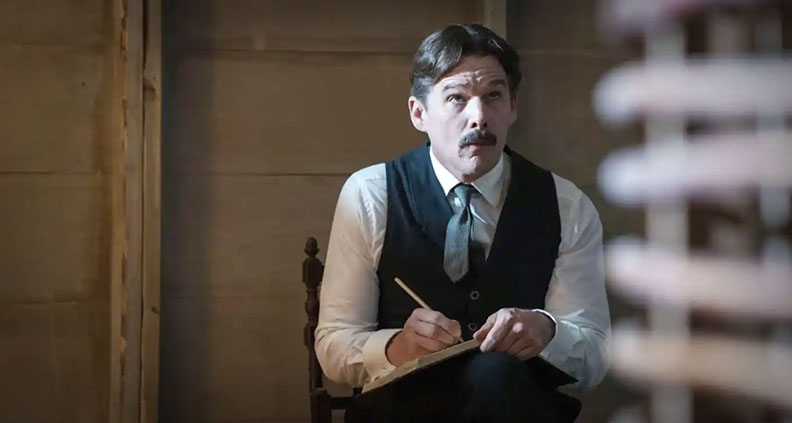
With Hawke attached, Singer and fellow producer Robbins connected at a Sundance party (naturally!) with financiers Millennium Media—a global sales-model enterprise primarily known for their work in the action genre. Soon, Tesla had funds committed.
Singer then brought his friend Robbins onto the project. During the financing stage, “There were some bumps, and the producer structure changed a little bit,” says Robbins. But as Singer says: “Ethan was the key to everything.” Amereyda agrees: “[Millennium] wanted to do an Ethan Hawke movie and I had Ethan Hawke attached, so they were persuaded to make their second-ever art movie.” However, Hawke’s busy work schedule did cause the film to shoot a full year later than originally anticipated.
Almereyda and the producers each declined to share Tesla’s final budget, but online research places it around $5 million. Whatever the figure, “It wasn’t chump change—if you found this amount of money laying around in a box, it’d definitely be one of the better days of your life,” laughs Robbins. But still: Enough money to shoot an intricately structured period piece about the life of Nikola Tesla? “No. It was not enough money to make a period film,” says Almereyda, flatly—also stating that he thinks of Tesla as a “science fiction film that takes place in the past.”
Of working with Millennium, Singer says, “They’re really delightful in every way. Millennium was like, here’s the money to make your money—don’t go over budget!” adding: “Their solution to going over budget wasn’t really something we wanted to face.” That said, they did go over budget—a little. “That’s the nature of indie filmmaking,” sighs Robbins.
But once again, Sloan came to the rescue—this time in the form of $200,000 additional support. “That really helped us get through some difficult times,” says Almereyda. “If I’m looking for money and I know there’s some reasonable science aspect, I know I can tap them [Sloan] on the shoulder. But I don’t take them for granted, I’m really grateful and wonderstruck about how generous they’ve been.” Says Singer: “It allowed us not to cut the days that were [going to be] cut. The grant and the willingness to help really allowed us to complete this movie.”
PRODUCTION
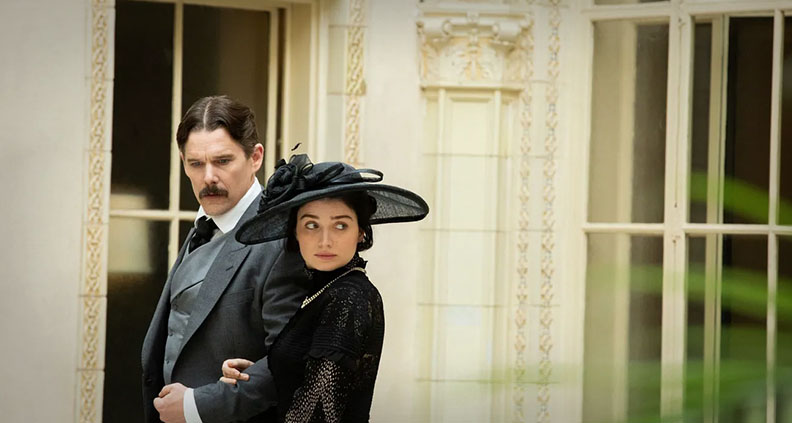
Tesla was shot in just 20 days in Brooklyn, New York with one additional day of pickups minus Ethan Hawke—21 days total. Millennium supplied producer Per Melita, who joined Almereyda, Singer, Robbins and the film’s other producers to handle day-to-day physical production. The team fabricated sets inside a large warehouse space in Brooklyn. “We were lucky to have resourceful location scouts and a good production design team,” says Almereyda. “We were able to cut a lot of corners that way.” The crew was small, but union. “Everyone was gunslingers,” says Robbins, “[Tesla] has the spirit of indie [cinema] for sure.”
For his Director of Photography, Almereyda used Sean Price Williams, whom he had worked with on Marjorie Prime, describing the cinematographer as “very resourceful and fast.” Robbins credits Hawke with “leading the actor charge” making sure performers felt welcomed and comfortable despite the production’s no-frills footprint. “It was ambitious, to say the least,” he says.
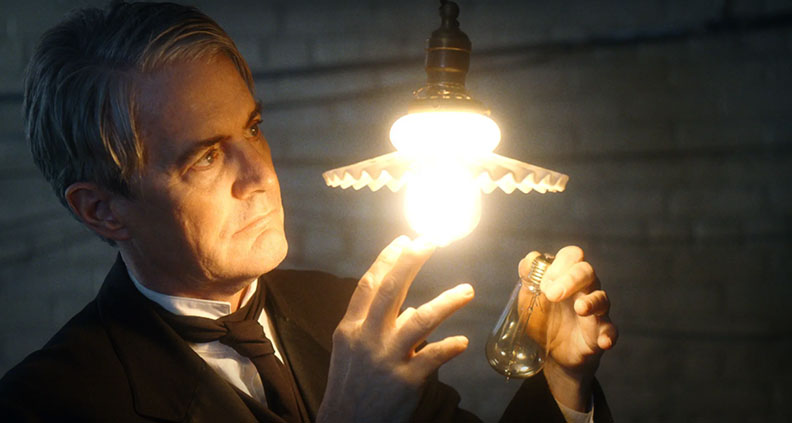
Asked what other production details were key, Robbins says: “It’s all about the costumes or you’re dead—our costumes came from a 1940s-set movie that our costume designer [Sofija Mesicek] took and altered for our time period,” the action of Tesla spanning roughly 1884-1901. He noted that after Tesla the same costumes were aged backwards yet again, to the 1840s, for the 2021 horror film The Last Thing Mary Saw. “Which is to say men’s fashion has not changed—men are so boring!” he laughs.
Post-production was completed over the course of three months in Bushwick, Brooklyn. Asked if financiers Millennium Media had any notes, Almereyda says: “They were very benign. I had final cut and they just wanted it brought in under budget.” According to Robbins, most of the studios notes were helpful and productive.
FESTIVAL STRATEGY
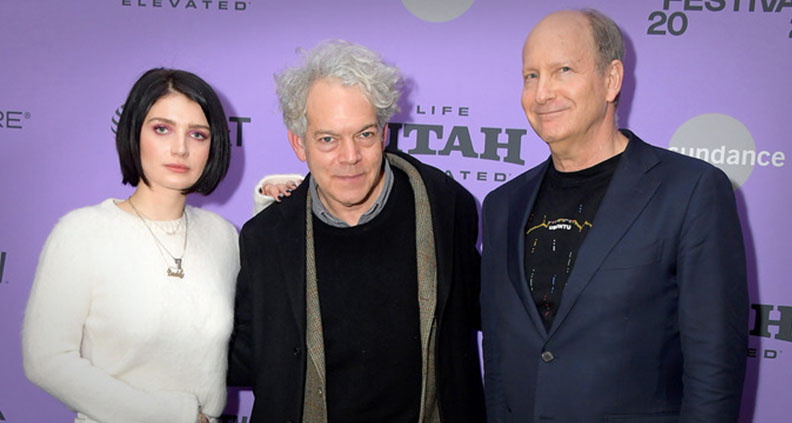
“Sundance has been super supportive to my career, Uri’s career and Michael’s career,” says Robbins. But Tesla’s slot in Park City was anything but a slam-dunk. “It wasn’t assured that we would get into Sundance,” says Almereyda. “We had done it before; that was our aim and ambition. But it was far from certain,” adding: “From what I can tell there’s really no inside track, the conditions and the jury have been different every time.” Robbins notes that Sundance Director John Cooper championed Tesla, calling him on his cell to give Robbins the good news that the film had gotten in—not a bad phone call to receive.
THE SALE & RELEASE
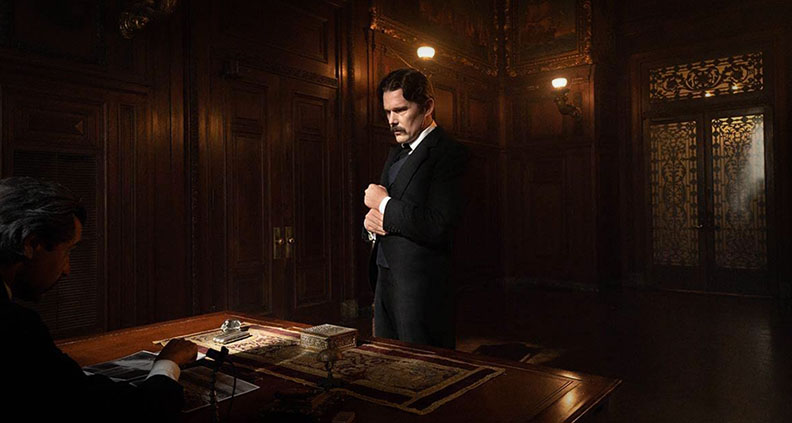
Tesla had already been pre-sold worldwide by financing studio Millennium Media, but it still need a US distributor. “If you have a good US release, your foreign [release] goes better,” says Robbins, who at one time worked in foreign film sales. He acknowledges that while this fact is in the process of changing, for now the formula still holds true. Enter veteran indie film sales agent John Sloss and Cinetic, who began negotiating with IFC Films to broker a distribution deal.
Says Singer: “When we had our [Sundance] premiere, we pushed [Sloss] a lot, and John Sloss is the kind of sales rep who keeps all his cards close to his vest.” Sloss had previously visited the Tesla set, where he first expressed an interest in representing the film.
Almereyda calls the IFC pickup “a natural and very fortunate combination” of relationships and sensibilities. Released on SVOD platforms at the height of the pandemic, the film nevertheless made it into over 150 theaters in states with less restrictive lockdown measures—Kansas and Montana, for instance.
Robbins praises IFC President Arianna Bocco in particular. “IFC came in with a substantial commitment, and whenever I get the chance to say who’s the best on the indie film circuit, it’s Arianna,” he says.
Filmmaker advice: Says Singer, “Theatrical distribution today is very difficult, so I would find a home first whether is distribution or a streamer. But don’t leave your dream. If you’re willing to spend two years or more on a project you have to be passionate about it. The day you see your credit onscreen, it’s all worthwhile.”
Film Independent promotes unique independent voices by helping filmmakers create and advance new work. To become a Member of Film Independent, just click here. To support us with a donation, click here.